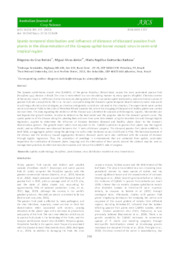Spatio-temporal distribution and influence of distance of diseased passion fruit plants in the dissemination of the Cowpea aphid-borne mosaic virus in semi-arid tropical region.
Spatio-temporal distribution and influence of distance of diseased passion fruit plants in the dissemination of the Cowpea aphid-borne mosaic virus in semi-arid tropical region.
Author(s): BATISTA, D. da C.; ALVES JÚNIOR, M.; BARBOSA, M. A. G.
Summary: The Cowpea aphid-borne mosaic virus (CABMV), of the genus Potyvirus (Potyviridae), causes the most prominent passion fruit (Passiflora spp.) disease in Brazil. The virus is transmitted in a non-circulating manner by many species of aphids. Chemical control of the vector insect is inefficient, due to the non-circulating nature of the virus-vector aphid relationship, and commercial species of passion fruit are susceptible to the virus. As such, comprehending the disease?s spatio-temporal dissemination dynamic may assist in outlining cultural control strategies, as chemical and genetic control are not used in this situation. The experiments were carried out in commercial fields in the cities of Petrolina-PE and Juazeiro-BA, where the mapping of diseased and healthy plants was carried out over time. The data regarding the incidence of the disease was submitted for analysis with Gompertz, Logistic, Monomolecular and Exponential growth models, in order to determine the best model and the progress rate for the disease?s growth curve. The spatial patterns of the disease along the planting lines and over time were determined using the doublets test and through logistic regression, applied to determine the influence of distance between diseased and healthy plants closer to the disease?s dissemination pattern. The growth model which best adjusted to the CABMV epidemics in passion fruit plants was the Logistic model, and no difference was observed between the ?r? rates of disease progress. The diseased passion fruit plants exhibited, in both fields, an aggregate pattern along the planting line with similar incidence values (4.16% and 6.74%). The fast development of the disease and the tendency toward aggregation between diseased plants were also confirmed with the analysis of distance through logistic regression. Thus, the production of seedlings in environments that are protected from aphids, systematic inspections for eradication of diseased plants (roguing) and the elimination of host weeds around the orchard may be used as management practices do eliminate inoculum sources and reduce the CABMV?s rate of progress.
Publication year: 2022
Types of publication: Journal article
Unit: Embrapa Semi-arid Region
Observation
Some of Embrapa's publications are published as ePub files. To read them, use or download one of the following free software options to your computer or mobile device. Android: Google Play Books; IOS: iBooks; Windows and Linux: Calibre.
Access other publications
Access the Agricultural Research Database (BDPA) to consult Embrapa's full library collection and records.
Visit Embrapa Bookstore to purchase books and other publications sold by Embrapa.

